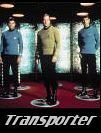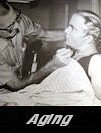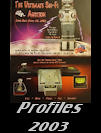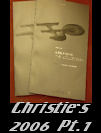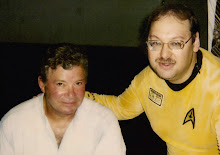A number of misconceptions have existed at different points in time about what characteristics were present on authentic Star Trek hand props. Those who have been collecting for decades will undoubtedly recognize a few of these assertions, once considered as "gospel" - and sometimes accepted as fact because they were remarks that were attributed to respected experts or actual TOS production crew members. I shall list the myth below and then show a TOS episode screenshot that dispels it!
1. Black and White Phasers were never used in Star Trek TOS. In fact, as many novice collectors now realize, Black and Whites did appear in a handful of episodes at the start of Season One (during the first 2 months of production) - but did not stand out well on film in the opinion of the directors, and were repainted to the familiar bluish-grey and black scheme. The Star Trek phaser prop was designed and constructed by TOS Art Director Matt Jefferies and his brother John Jefferies, a production designer. The repainting of the black & whites was performed by famous prop artist Wah Ming Chang, who is sometimes mistakenly credited with the design of the phaser.
2. All Tricorders had 3 blue colored jewels on their control panels to simulate indicator lights. This myth became popular when it was observed that one or more authentic Tricorders which were on public display at Star Trek conventions in the 1980's (as part of major collections) had 3 blue jewels. In fact, 3 blue jewelled Tricorders did exist (and sometimes the all blue color scheme was thought to be a means of designating the device as a "Sciences" Tricorder); but other Tricorders certainly appeared in TOS episodes with different and seemingly random jewel color schemes. The screenshot below is from "Day of the Dove"

3. The viewscreen embedded in tricorders was always designed the same size according to a fixed aspect ratio, which was that used in a typical 1960's television set. In fact, I have documented several different aspect ratios on Tricorder screens. A few are presented below.
4. There were never any Leatherette Tricorders in Star Trek, a myth circulating for many years that was recently given enhanced credibility by a well known prop maker in a technical article for the Star Trek Communicator magazine, based on the recollections of one of the TOS production crew members. Some screenshots that serve to dispel the myth ...

5. All communicators featured brass antenna plates with prepunched holes. This myth was advanced in the fan community and also forwarded by respected auction house staff; and might have arisen based on different fabrication techniques used by Wah Chang and the Desilu prop department. In the following screenshots from "Friday Child" and "Omega Glory", manually punched antenna meshes are clearly visible. Noted propmaker Richard Coyle mentions on his site that a number of new brass antennas were fabricated by the Desilu prop department for communicators in the 3rd season.
6. Only 10 Communicators were used in Star Trek and they were all created by Wah Chang. This particularly damaging myth has been spread by a very well known fan-created website called HeroComm, that is often applauded for its "excellent" research. While paperwork from Wah Chang has been found that does document a single sale of 10 communicators to the Desilu Star Trek office; it is extremely naive to assume that no other communicators were created since no other paperwork is known to exist. HeroComm displays the following composite photo on their site of the 10 "known" authentic communicators:













































